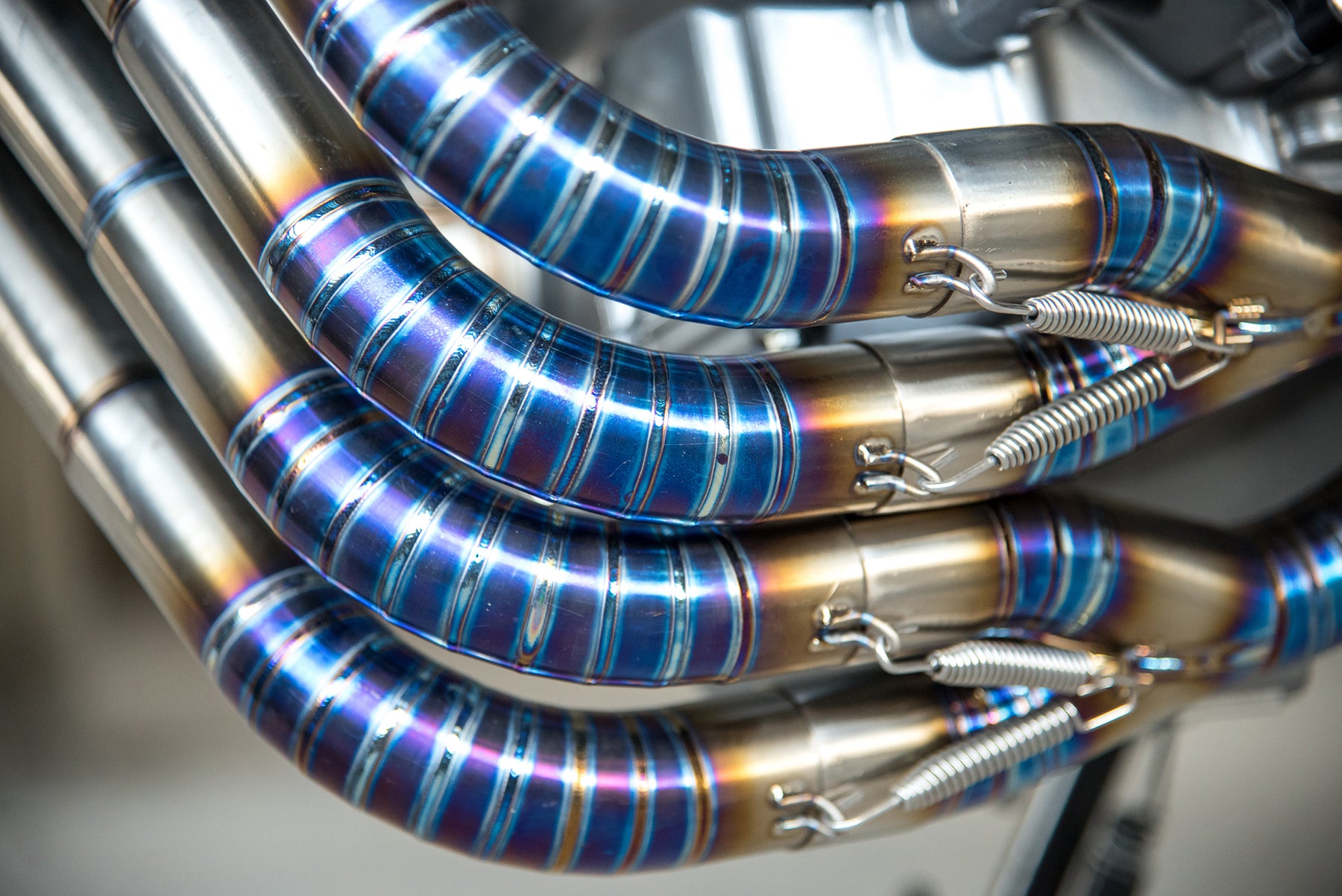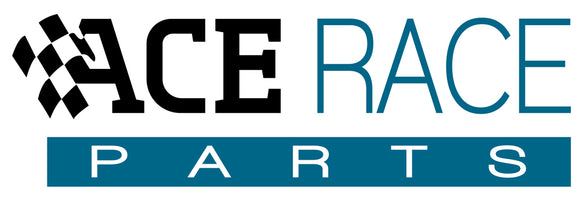
Comparing 304 Stainless Steel and Titanium in High Performance Exhaust Systems
High performance exhaust systems are a crucial aspect of the performance and efficiency of vehicles. The material used in the construction of these systems significantly impacts their durability, heat resistance, weight, and ultimately, their performance.
Two of the most popular materials used in the fabrication of high-performance exhaust systems are 304 Stainless Steel and Titanium. Both of these materials offer a unique blend of characteristics ideal for this high-heat, high-stress application. However, they each bring their own set of advantages and challenges to the table. Let's delve deeper into these materials and understand their differences, as well as their pros and cons.
 Stainless Steel Exhaust, Courtesy of AWE Tuning | www.awe-tuning.com
Stainless Steel Exhaust, Courtesy of AWE Tuning | www.awe-tuning.com
304 Stainless Steel
304 Stainless Steel is one of the most widely used grades of stainless steel. Its composition includes approximately 18% chromium and 8% nickel, along with a mix of iron, carbon, manganese, and silicon. This blend gives it its characteristic high corrosion resistance and durability.
The addition of chromium forms a passive layer of chromium oxide that prevents further surface corrosion and blocks corrosion from spreading into the metal's internal structure. Nickel, on the other hand, enhances the overall corrosion resistance while also increasing the alloy's formability and ductility.
Pros of 304 Stainless Steel
1. Corrosion Resistance: 304 stainless steel has a high resistance to rust and corrosion, making it ideal for exhaust systems exposed to various environmental conditions.
2. Cost-effectiveness: Compared to titanium, 304 stainless steel is generally more affordable, making it a cost-effective choice for many applications.
3. Durability and Toughness: One of the primary advantages of 304 stainless steel is its high durability and toughness, even at extremely low temperatures. This toughness is maintained due to the presence of nickel within the alloy.
4. Availability and Fabrication: This material is widely available and easy to work with, allowing for a wide range of shapes and designs.
5. Weldability: 304 stainless steel is easy to weld, making it an excellent choice for an exhaust system where complex shapes and structures might be required.
Cons of 304 Stainless Steel
1. Weight: Compared to titanium, 304 stainless steel is significantly heavier. This extra weight can affect the overall performance of a vehicle, especially in racing applications where every ounce counts.
2. Heat Discoloration: Stainless steel can change color when exposed to high temperatures, a phenomenon known as "bluing". Although this doesn't affect the material's performance, it may be a cosmetic issue for some.
CHEMICAL COMPOSITION OF 304 STAINLESS
The chemical composition of 304 Stainless Steel is as follows:
- Iron: 66.345 - 74%
- Chromium: 18 - 20%
- Nickel: 8 - 10.5%
- Manganese: 2% max
- Silicon: 1% max
- Carbon: 0.08% max
- Phosphorus: 0.045% max
- Sulfur: 0.03% max
- Nitrogen: 0.1% max
The specific percentages of each element may slightly vary based on the manufacturing process and the specific requirements of a given application. Each of these elements contributes unique properties to the alloy. The combination of iron, chromium, and nickel provides 304 stainless steel with its notable corrosion resistance, strength, and formability. The other elements play a role in further refining its properties and improving its workability.

Titanium Exhaust | Courtesy of Unobtanium Welding | www.unobtainium.ca/
CP1 Titanium
Commercially Pure Titanium (CP1 Titanium) is the purest form of titanium, with a titanium content of 99.5%. This grade of titanium is renowned for its excellent ductility, high impact toughness, and superior corrosion resistance, even compared to other grades of titanium. It's often used in applications where weight reduction is crucial, such as in racing exhaust systems.
Pros of CP1 Titanium
1. Exceptional Corrosion Resistance: CP1 Titanium's resistance to corrosion is a standout feature. It can resist attack by acids, alkalis, natural waters, and industrial chemicals. This makes it an excellent material for exhaust systems, which have to endure a variety of harsh conditions.
2. Low-Density and High Strength: CP1 Titanium has one of the highest strength-to-density ratios of any metallic material. This makes it incredibly strong yet light, which is particularly beneficial in automotive applications where weight reduction is essential for performance.
3. Excellent Thermal Stability: This material maintains its strength even at high temperatures, making it an excellent choice for exhaust systems where heat resistance is a priority.
4. Heat Resistance: Titanium exhaust systems can handle high exhaust temperatures better than their stainless steel counterparts. They don't discolor as much under heat, maintaining their aesthetic appeal.
Cons of CP1 Titanium
1. Cost: The primary disadvantage of CP1 titanium is its cost. It is significantly more expensive than 304 stainless steel, which may make it less appealing for some applications.
2. Fabrication Challenges: CP1 Titanium requires specialized equipment and techniques for processing and fabrication. It's not as easy to work with as more common metals like steel or aluminum. This, combined with its cost, can make it a less attractive option for some applications.
CHEMICAL COMPOSITION OF CP1 (GRADE 4) TITANIUM
CP1 Titanium, or Grade 4 Titanium, is the strongest of the four commercially pure titanium grades.
The chemical composition of CP Grade 4 Titanium is:
- Titanium: 99.5% min
- Iron: 0.50% max
- Carbon: 0.08% max
- Nitrogen: 0.05% max
- Hydrogen: 0.015% max
- Oxygen: 0.40% max
The minor elements such as Iron, Carbon, Nitrogen, Hydrogen, and Oxygen in CP Titanium are impurities that are not typically added intentionally but are found naturally. These elements contribute to the strength of the titanium alloy, and in higher concentrations can affect its ductility, formability, and weldability.
Conclusion
In conclusion, the choice between 304 stainless steel and CP1 titanium for a high-performance exhaust system boils down to the specific requirements of the application and budget constraints. If cost and ease of fabrication are key concerns, 304 stainless steel would be a logical choice. However, for applications where weight reduction and heat resistance are of paramount importance, such as in competitive racing, the benefits of CP1 titanium could justify its higher cost. As always, it's advisable to consult with an experienced automotive engineer when making such decisions.

Leave a comment